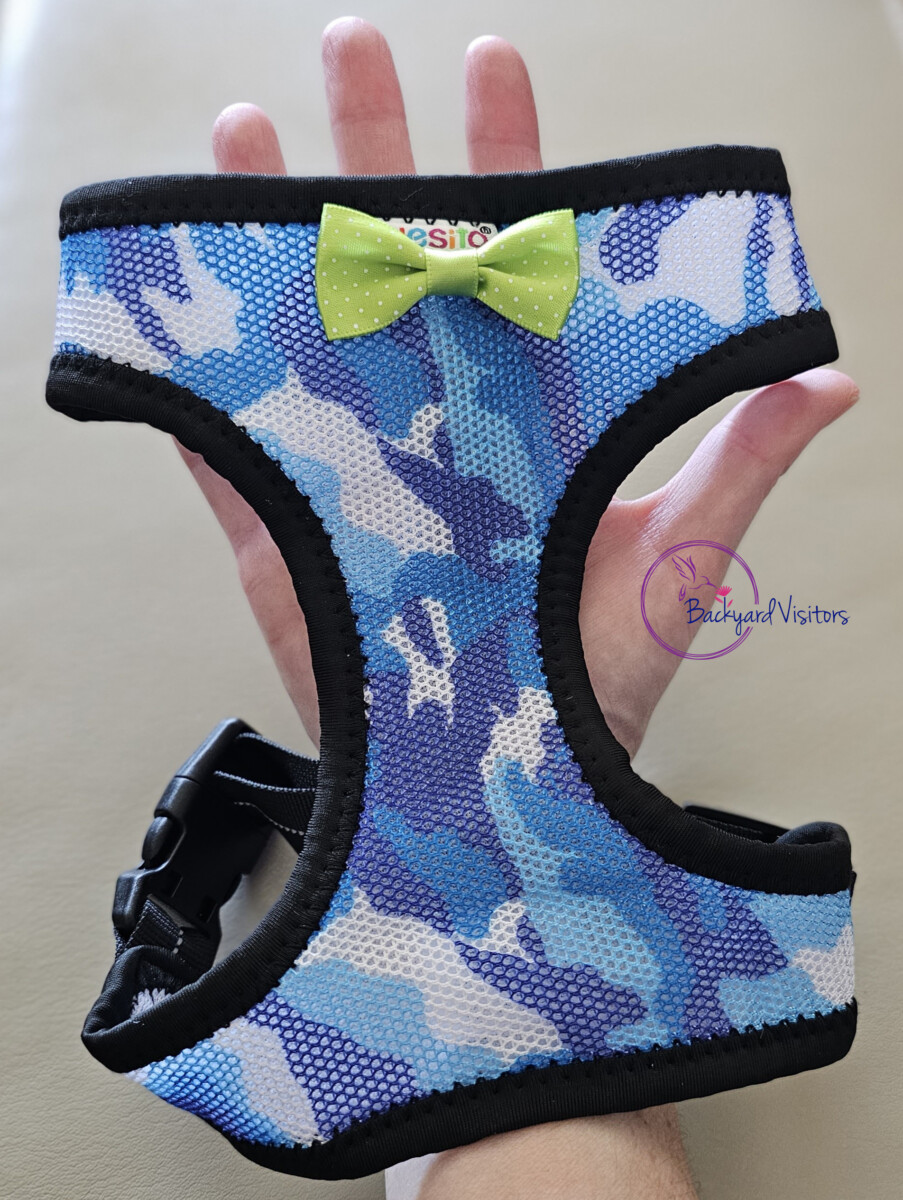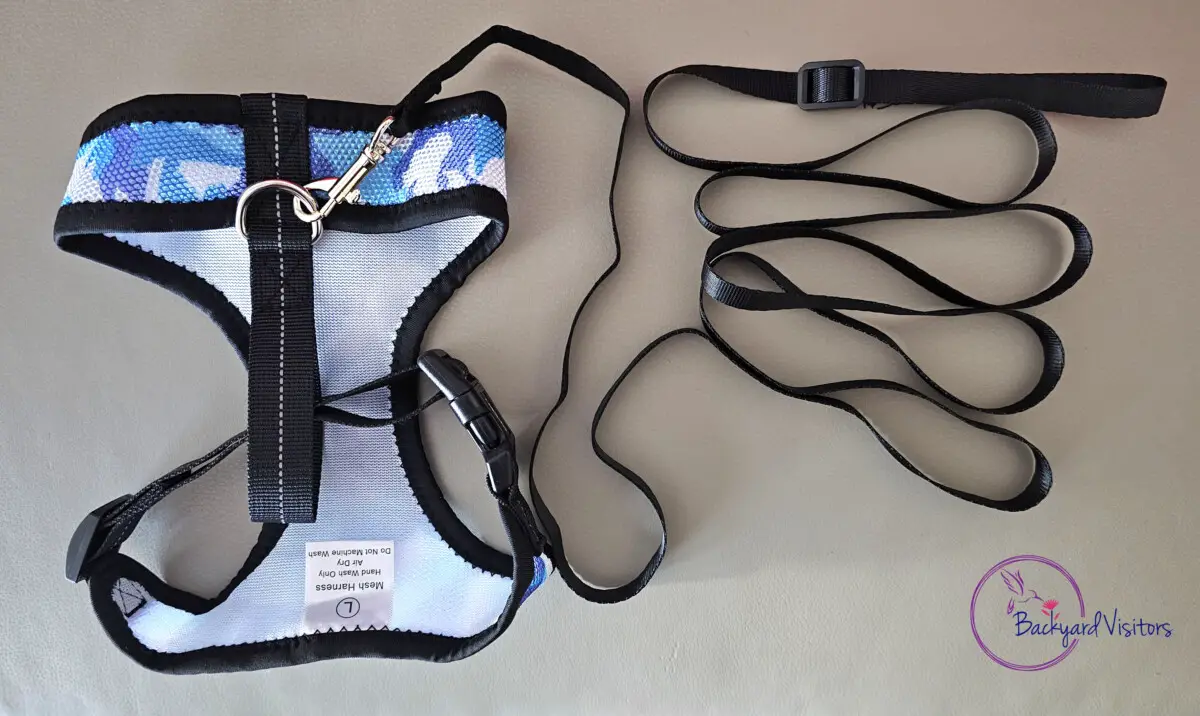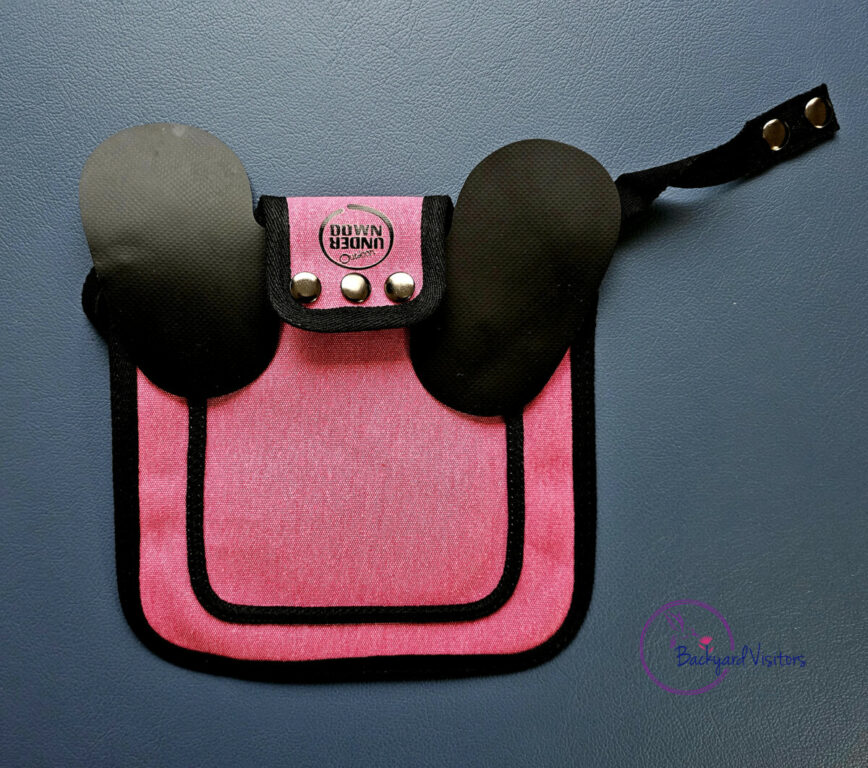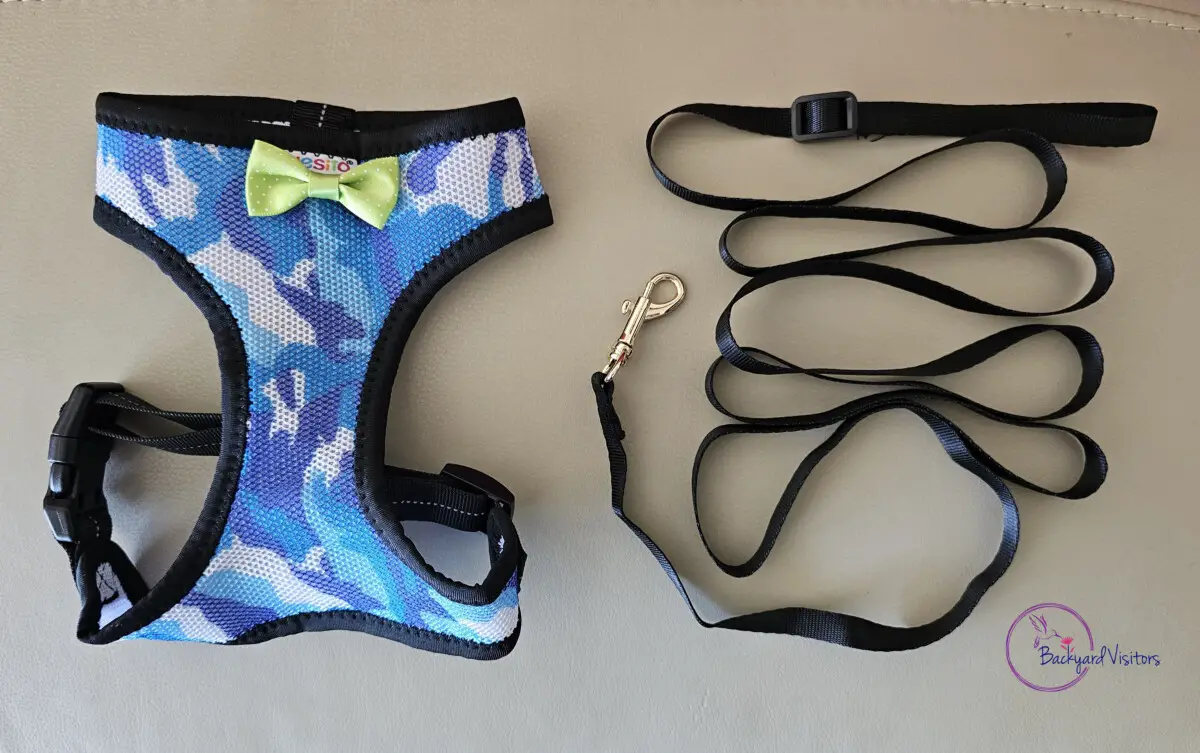This post contains affiliate links.
This article is all about using a chicken harness, what equipment is needed, the purposes of using a chicken harness, how to put the harness on, and how to train the chicken to wear a harness.
Can I Walk My Chicken With A Chicken Harness?
Using a chicken harness to walk a chicken is feasible, but it calls for close attention to a few details. These details include the use of a dedicated harness and leash, the temperament of the chicken, supervision, a suitable location, and the need for patience in training.
For chicken enthusiasts, there is a growing trend to provide their pet chickens with exercise and exploration opportunities by walking them with a chicken harness and leash.

Always check local regulations and ordinances to make sure you are allowed to walk chickens in your area.
In some public areas, consider using a chicken diaper to prevent any messes.
For more information on using chicken diapers, read my article:
Chicken Diapers For A Clean Home: Easy As 1-2-3
Ensure that your pet chicken is healthy and free from diseases before taking it for walks.
Regular veterinary checkups are important.
For more information about owning a chicken as a pet, read my article:
Pet Chickens 101: Everything You Need to Know
Remember that not all chickens will enjoy or are suited for walks. Chickens are animals of prey and feel vulnerable when something restricts their movement. Some chickens may become stressed or agitated when taken out of their familiar environment.
Any chicken can be tamed with frequent handling and kindness. Yet, the chicken breed plays a strong role in the success or failure of training a chicken to walk on a leash. The chicken’s personality dictates the success or failure of adapting to being walked. Calm, friendly, docile, and compliant birds are more likely to adapt to the experience.
Buff Orpingtons, Cochins, Silkies, and Leghorns are some of the easiest chicken breeds to train to wear a chicken harness.
Though there are cases of roosters being trained, due to their innate aggressive personalities, they are less suitable for harness training.
To learn more about roosters, read my article: Getting to Know Roosters: A Basic Guide
It is essential to prioritize your chicken’s well-being and comfort. If your chicken seems stressed or unhappy during walks, it is best to find alternative ways to provide them with exercise and stimulation.
Harness training provides chickens with outdoor enrichment, bonding, exercise, and socialization. This makes it useful for therapy and outdoor activities.
A chicken harness is specially designed and allows owners to take their chickens on a controlled walk, similar to walking dogs. The harness consists of a loop that goes over the chicken’s head. Two straps wrap around its body and under the wings. The harness is attached to a leash.
The harness is made from a breathable, flexible mesh material that is gentle on your chicken’s feathers and easy to clean. Using the harness ensures the chicken’s safety and comfort during outdoor excursions.
A chicken harness that is a favorite among people with pet chickens is the Yesito chicken harness and leash .
Step-by-Step Process To Chicken Harness Training
Begin the process with a young chicken since it is much easier than with a mature chicken already set in its ways.
Choose the right harness size for your chicken so as not to cause stress, discomfort, or feather damage. It is imperative that the harness fits snugly without constriction and does not harm the bird’s plumage.
A harness that is too large will allow your chicken to escape. One that is too small will cause discomfort.
The common sizes of chicken harnesses are Bantam, Standard, and Large.
Pick the one that best suits your chicken.
Choose a safe and quiet place to walk your chicken away from potential predators and traffic. Always prioritize the safety and comfort of your chicken. A backyard or garden with a fenced area is a good starting option.
Be mindful of the weather since extreme heat or cold temperatures are uncomfortable for your chicken. Choose a time of day when the weather is mild.
Gradually introduce your chickens to the chicken harness before venturing outside.
Start with short indoor handling and treat sessions.
Increase the time your chicken wears the chicken harness, and then introduce and familiarize them with the leash.
The training process takes time and lots of patience, so keep the sessions short, positive, and consistent.
Use high-value treats such as mealworms during harness training to encourage and reward them for good behavior. This reinforces an enjoyable experience for your chicken.
A lightweight 6-foot leash is introduced and attached to the chicken harness once your chicken is comfortable wearing the harness. Attach the leash by clipping it to a ring on the back of the harness. This keeps your chicken from feeling weighed down and prevents any pressure or constriction around the chicken’s neck while she explores. Any tension from the leash is distributed around the chicken’s body.
Positive reinforcement and plenty of patience are the keys since the process is arduous but ultimately rewarding for both the chicken and the owner.
Always supervise your chicken to avoid accidents while walking with your harnessed chicken since they are easily frightened or startled.
Keep the walks short, especially when first introducing your chicken to the experience. Over time, extend the duration of your walks as much as your chicken tolerates.
Time, patience, and diligent efforts are required to acclimate them to the chicken harness and leash.
When considering walking your chicken on a leash and using a harness, early-onset training, frequent handling, the right-sized harness, avoiding stressful situations, and carrying treats for positive reinforcement are the keys to success.
Chicken harnesses are a fantastic way to walk your chicken for some supervised outdoor fun. While it takes time and dedication, the rewards of having a chicken companion on your outdoor adventures are priceless. If you have a friendly, calm, and docile hen, give harness training a try! It might just open up a whole new world of experiences for you and your chicken.
What Is The Purpose Of A Chicken Harness?
A chicken harness is an accessory that enables controlled walking excursions for pet or therapy chickens. The chicken harness and leash are used to promote exercise and bonding with pet owners, or in therapy sessions with patients while ensuring safety and protection for the chicken.

A chicken harness is a specialized accessory accompanied by a leash primarily designed for chickens, allowing their owners to safely and securely take their chickens outside for a variety of reasons, including:
Exercise and fresh air: Chickens benefit from outdoor time to peck, scratch, and explore, which contributes to their well-being and mental stimulation.
Bonding with the owner: Taking a chicken for a walk on a harness is a way for chicken owners to bond with their pets and spend quality time together.
Training and socialization: Some chicken owners use harnesses as part of a training or socialization regimen, allowing the chickens to become more comfortable around people or other animals.
Educational purposes: Educators or agricultural enthusiasts use chicken harnesses to teach others about poultry care and behavior.
Therapy purposes: Experts utilize chickens to treat mental health problems in people.
They are used in both individual and group sessions.
Therapy chickens are effective in nursing home visits to combat loneliness.
Safety and control: A harness provides a level of control over the chicken’s movements, preventing it from wandering into dangerous areas or getting lost.
Protection from predators: When used in conjunction with a leash and supervision, a harness can offer some protection from potential predators while the chicken is outside.
A chicken harness serves the purpose of facilitating controlled outdoor excursions for chickens, offering benefits such as exercise, training, and bonding with their owners, all while ensuring the birds’ safety and protection from potential threats.
A favorite harness of pet chicken owners is the Yesito Chicken Harness.
It is important to note that not all chickens tolerate or benefit from being harnessed, and introducing a chicken to a harness is always done with care and patience.
The well-being and comfort of the chicken are always the top priority when using a harness. Additionally, the harness should fit comfortably and securely without causing any harm or distress to the chicken.
Can You Put A Harness On A Chicken?
While it is possible to put a harness on a chicken, there are challenges and stressors for the chicken. For safe and guided exploration during outings, success depends on the individual chicken’s temperament, gradual introduction, proper harness and leash adjustments, and the handler’s patience.
Suburban and urban pet chicken owners are increasingly harness-training and leash-walking their feathered companions, similar to walking dogs.
Putting a harness on a chicken is possible and happens more often than you may realize.
It is a challenging and potentially stressful experience for the chicken. Chickens are not naturally inclined to wear harnesses and often resist the process.
Pet chicken owners use a chicken harness for various reasons, such as taking chickens for walks, using the chicken for therapy, preventing them from flying over fences, training and socializing for competitions, and for educational or therapy purposes.
If you want to use a chicken harness on a pet chicken, here are some general considerations to follow:
Select the right harness: There are special chicken harnesses designed for comfort and safety. It is essential to use a harness specifically designed for chickens to avoid harm.
Introduce the harness gradually: Chickens are skittish as they are prey animals; therefore, take time to get them accustomed to the harness. Allow them to see, peck, and investigate the product before attempting to put it on.
Prepare the chicken: Gently pet them, capture the chicken, and hold it securely without applying too much pressure. Ensure the chicken is calm before proceeding.
Put on the chicken harness: Carefully slip the harness over the chicken’s head, wings, and body.
See the instructions for putting on the chicken harness earlier in this article.
Adjust and secure: Once the chicken harness is on, adjust it so that it fits comfortably. Be sure it is secure but not too tight to avoid restricting the chicken’s movements. Allow two fingers to fit under the harness. Also, make sure it is not too loose, allowing them to slip out of it.
Monitor the chicken: Keep a close eye on the harnessed chicken. Some chickens adapt better than others, while others may not tolerate it at all.
Practice and reward: If your hen appears at ease wearing the harness, take it for brief walks or time spent outside under supervision. Reward the hen for her cooperation with mealworm treats or other forms of positive reinforcement.
It is important to note that not all chickens tolerate the stress of a chicken harness. If your pet chicken appears to be extremely distressed or agitated, it is best to remove the harness and not force the issue.
Additionally, be cautious when taking chickens outside, as they can be vulnerable to predators. Make sure the environment is safe for them.
Chickens can be harnessed, and ultimately, the suitability of using a harness on a chicken depends on the individual chicken’s temperament and your specific needs. If it is not well-received or seems to stress the chicken, it is best to explore other methods for managing your chickens.
How Do You Train A Chicken To Wear A Chicken Harness?
The most gentle and successful way to train a chicken to wear a chicken harness is to first use a chicken saddle, then, once the chicken is comfortable with the saddle, introduce the chicken to the chicken harness, and finally integrate the leash into the training process.

Have cute chicken harnesses online grabbed your attention, and now you want to try them with your feathered friend? Training a chicken to wear a harness is a unique and enjoyable endeavor, but it requires patience and a gradual approach.
The benefits of harness training allow for various outdoor activities for you and your pet chicken. Chickens, while not conventional candidates for leash-walking, enjoy outdoor activities such as brief hikes, rides in a bicycle basket, or as therapy chickens that visit nursing homes or special public engagements.
Here is a step-by-step guide to help you train your chicken to wear a harness:
1. Acquire the Right Equipment: Pet supply stores and internet retailers carry chicken harnesses along with a leash. Verify that the size is appropriate for your chicken.
- A favorite saddle of pet chicken owners is the Down Under Chicken Saddle.
- A favorite harness of pet chicken owners is the Yesito Chicken Harness.
2. Familiarization: Before introducing the harness, spend time with your chicken so it becomes comfortable around you. Hand-feeding treats helps to build trust.
For more information about this process, read Section 8 of my article:
Pet Chickens 101: Everything You Need to Know
3. Introduction of the Saddle: For gentleness, begin chicken harness training by using a chicken saddle before the introduction of a harness. Hens are much more tolerant of a saddle compared to their tolerance of a harness.
A chicken saddle is protective clothing made specifically for chickens. It is sometimes referred to as a hen apron or a chicken apron. A chicken saddle protects the chicken’s back feathers from the rooster while mating.
For more information about roosters, read my article:
Getting to Know Roosters: A Basic Guide
Let her wear it for a few days and nights. The main purpose of the saddle in this situation is to help your chicken get used to having something on her back and across her front.
If a chicken saddle is fitted correctly and does not hurt the chicken or limit its ability to move, it is fine to leave it on for several days at a time.
After a few days, she should be comfortable with the idea of wearing something. Remove the saddle and try the harness. It will be less irritating and bothersome. If she is still unsettled, a few more days with the saddle will do the trick.
4. Introduction of the Harness: Show the harness to your chicken without trying to put it on. Allow the chicken to inspect it and get used to its presence.
5. Gradual Introduction: Start by placing the harness on your chicken for short periods, just a minute or two at first, since the first introduction can frighten your chicken. Gradually increase the duration as your chicken becomes more comfortable.
6. Positive Reinforcement: Reward your chicken with treats such as mealworms and gentle praise when it wears the harness without distress. This encourages cooperation.
7. Remove Harness When Stressed: If your chicken shows signs of distress, such as flapping its wings or having extreme discomfort, remove the harness immediately. It is essential not to force the harness on your chicken.
8. Regular Practice: Continue with short, positive harness-wearing sessions over several days or weeks. The goal is to ensure your chicken associates the harness with positive experiences.
9. Leash Attachment: Once your chicken is at ease wearing the harness, fasten the leash and allow her to guide you around. Start in a secure outdoor area. Let your pet chicken explore with the leash attached.
Chickens do not weigh a lot and do not respond well to fast, quick corrective movements on a leash; therefore, avoid retractable leashes. Your chicken will get used to it with time and practice.
10. Outdoor Walks: Gradually progress to short outdoor walks with supervision. Keep in mind that chickens will not walk on a leash like dogs; however, they will explore and enjoy some outdoor time with you at their own pace.
11. Safety First: Always prioritize your chicken’s safety and well-being. Be cautious of potential hazards and avoid busy or noisy areas.
Harness training is a fulfilling way to spend time with your pet chicken; however, recognize that not every chicken responds well. If your chicken is not comfortable, then stop the process.
If your docile chicken is open to this activity, have fun and enjoy your time with your feathered companions!
What Do I Need To Be Able To Walk My Chicken?
To walk a chicken, the initial essential equipment includes a docile, agreeable chicken, a well-fitting chicken harness, a soft non-retractable lightweight leash, and treats. Also helpful are a chicken health check, a quiet location, a good attitude, patience, persistence, and repetition.
Walking a chicken with a leash is an unconventional but enjoyable and rewarding activity. It provides a way to spend time with your feathered companion.
To walk a chicken, one needs a chicken harness and leash.
A chicken harness that is a favorite among people with pet chickens is the Yesito chicken harness and leash.

Here are some guidelines and methods to walk your chicken safely:
- Examine your chickens’ health and make sure they are clear of parasites or illnesses before walking them in public.
- Purchase a specialized chicken harness, designed to fit your chicken comfortably and allow a leash to be attached. Make sure it is the appropriate size for the breed and size of your chicken. Chicken harness sizes are designated as Bantam, Standard, and Large.
- When fastening the harness, use caution and make sure it is not excessively tight or loose. There should be no restriction on your chicken’s mobility or respiration caused by the harness.
- Use a lightweight, non-retractable leash that is long enough to give your chicken some freedom but not too long to risk tangling or injuring the chicken.
- Gradually acclimate your chicken to wearing the harness. Start by letting the chicken wear the harness without the leash for short periods of time, either inside its coop or in a safe, enclosed area.
- Choose a calm and quiet place for your chicken walk, away from busy roads, dogs, and potential predators.
- Know your chicken’s personality. Some chickens may adapt well to walking, while others may not enjoy it. Always prioritize your chicken’s comfort and safety.
- Begin with short walks, and let your chicken get used to the experience. Monitor their behavior and stress levels. If your chicken seems distressed, take them back to their coop or safe area.
- Let your chicken explore at their own pace and keep the leash loose. Do not pull on the leash, as it will cause stress or discomfort.
- Reward your chicken with snacks when it behaves well on walks. This contributes to the event being positively associated.
Never leave your chicken unattended while on a leash, as they are prey animals and easily startled, causing them to get entangled within the leash, resulting in injuries.
Regular health checks, positive reinforcement, and a tranquil walking environment are essential components for a successful outcome. Check for any indications of pain or injury on a regular basis.
Keep in mind that not every hen will want to be walked; some may even get frightened or anxious. It is critical to prioritize your hens’ comfort zone and refrain from pressuring them to engage in an activity they find unpleasant.
Ensuring the chicken’s comfort, safety, gradual acclamation, and well-being is paramount. This involves gentle training, proper supervision, and awareness of the chicken’s individual temperament.
Check out my other posts on Backyard Chickens
Enjoy Being Walked By Your Pet Chicken!
Backyard Visitors is a participant in the Amazon Services LLC Associates Program, an affiliate advertising program designed to provide a means for sites to earn advertising fees by advertising and linking to Amazon.com. We also participate in other affiliate programs which compensate us for referring traffic.

